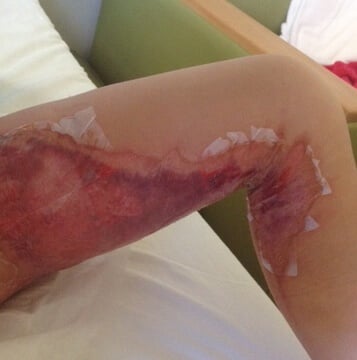
*EDITOR'S NOTE: This article was amended on 30 September 2022, to remove an image in line with privacy concerns.
Five years ago, a hot water bottle caused a massive amount of pain and suffering for the Botha family and especially to little Minke.
It was getting cooler at night, and 5-year-old Minke asked mum Marilize to fill the small hot water bottle she had received as a gift. She wanted to hold it while Marilize was busy feeding her brother, who at that stage was 13 months old.
"After a while, I heard a scream coming from her room. Minke had sat on her hot water bottle, and the rubber at the bottom of the bottle burst, spilling the boiling water over her buttocks and left leg. When we tried to pull her pants down, the skin came off with it. My husband immediately rushed her to hospital," said Marilize, a senior graphic designer.
Marilize explains that initially, the doctor who was working in casualties thought it was second-degree burns and sent Minke home with burn shield on. When they went back the next morning to get the burn shield removed, the doctor who was on duty recommended that Minke should instead be admitted to hospital and that the wounds be adequately cleaned under anaesthesia.
Full-thickness burns, or third-degree burns, is when the wound has gone through all the layers of the skin. There is no reddening or swelling, and the skin appears greyish-white and leathery. There may also be some charring.
The recovery process
Unfortunately, the recovery process for little Minke was arduous.
She was in the hospital for three weeks which included six theatre visits where she received skin transplants from the healthy parts of her body to the affected regions. With the help of a physiotherapist, she also had to regain full function in her leg as the boiling water burned the skin and the fat layer on top of the muscle in her leg. After she was discharged from the hospital, she still had to visit the wound clinic every month. She also had to wear warm, pressure garments made by a physiotherapist, as well as see a dermatologist for laser treatments.
"The laser treatments were necessary to soften the keloids (a type of raised scar) that formed on her skin. These sessions lasted about 10 minutes and cost about R9 000 per session which included sedation. She also went to see a child psychologist," said Marilize.
Marilize understands all too well that accidents can happen and most likely will. She offers the following advice: "Learn from what had happened to Minke. Hot water bottles aren’t always safe. You never really know how old the rubber is. Especially children can easily mistake it for a toy. Rather use a beanbag in the winter and do what you can to avoid unnecessary heartache."
Minke, now 10 years old, is doing well and has grown into a strong young girl.
"She has a very strong personality and at this stage handles the scars on her body well. Her teenage years lie ahead of her, and we hope she stays as strong as she is," said Marilize.
Children more susceptible
Russel Meiring, ER24's communication officer, explains why children are more susceptible to burn wounds.
"Burns can be very serious in both children and adults. However, young children are more likely to sustain burn wounds as they are more accident prone and do not understand the safety aspect regarding fire, electrical appliances, and so on."
According to Meiring, the most common causes of burn injuries happen in and around the home. The kitchen is a prime area for these accidents to occur.
"These injuries can include children pulling over pots of boiling water, touching hot elements on the stove, exposed heater elements as well as hot baths. Young children should never be left unattended around any source of heat. Pots of water or boiling liquids should be kept well out of reach to prevent them from being pulled off. Heaters, which are a common cause of heat injuries, should also be kept out of reach of children and only be used by an adult."
What should people do when they’ve sustained serious burn wounds?
The first line of treatment for any burn injury would be to cool the affected area. This would entail running the affected area under cool, clean running water. Once the area has been cooled, a sterile burn dressing should be applied to the area.
Should the area be a large one or on a sensitive area, such as the face, medical attention should be sought immediately.
Home remedies, such as applying butter, oils, shoe polish, etc., should never be used as these remedies can cause further harm.
If you are unsure, seek medical attention. It is not recommended to remove clothing that is burnt into the skin. However, this is not always obvious and may only be noticeable when flames were present. If in doubt, cool the area with the clothes in place and seek medical attention.
Share with us:
Share your tips for keeping safe this winter, and we could publish your story. Anonymous contributions are always welcome.
Read more:
Dangerous children's toys and hazards to look out for
"My kid bumped his head!" When you should seek medical attention




 Publications
Publications
 Partners
Partners













